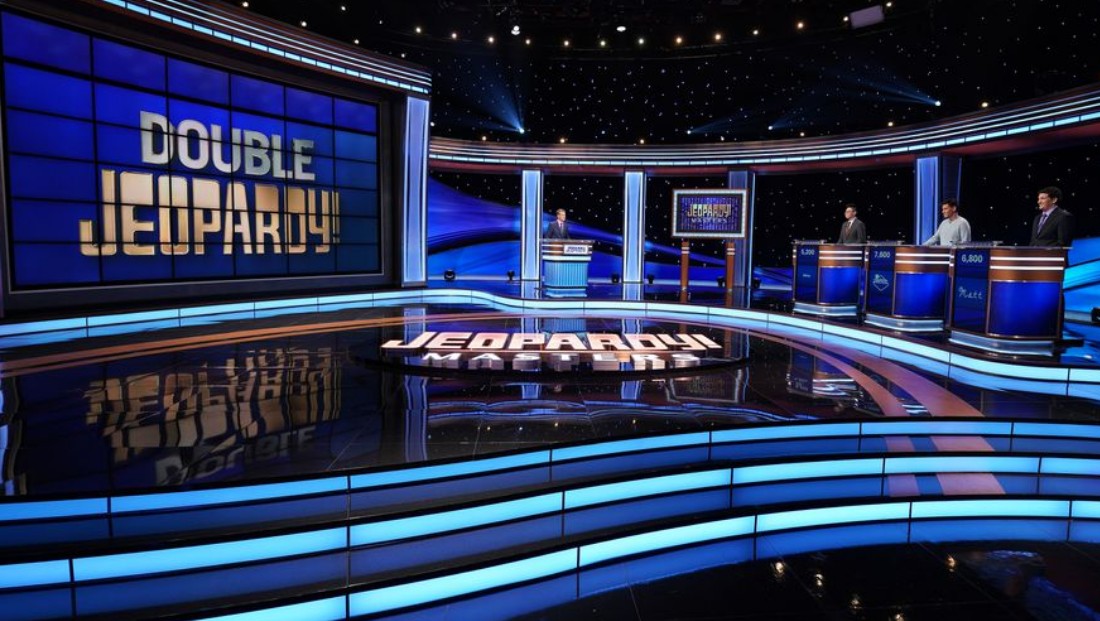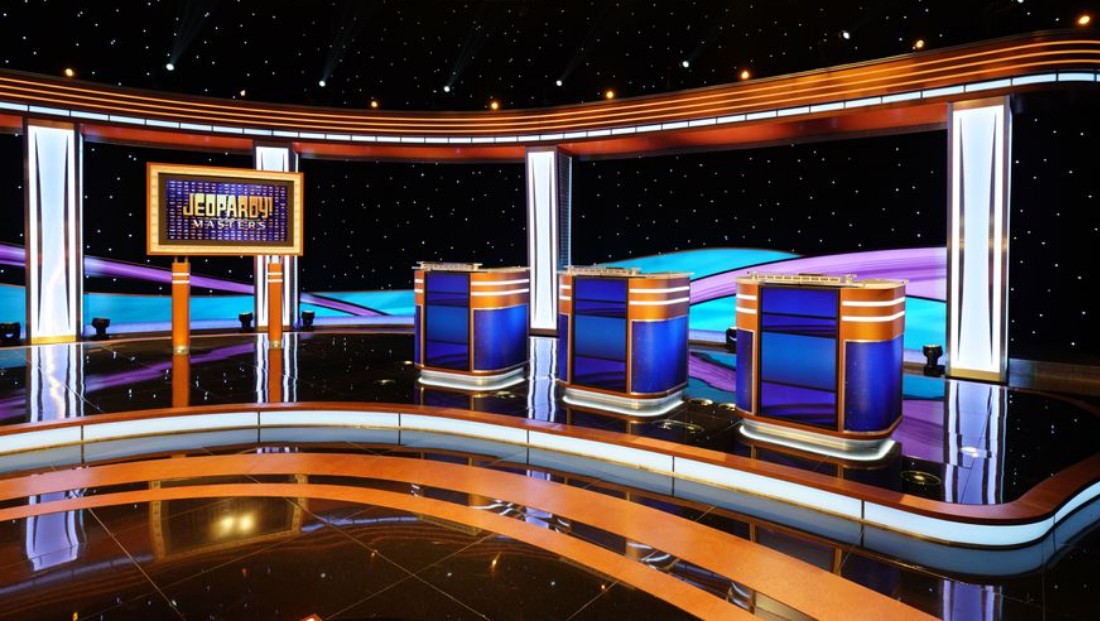‘Jeopardy!’ looks to its game board to create epic look for ‘Masters’ tournament

Subscribe to NCS for the latest news, project case studies and product announcements in broadcast technology, creative design and engineering delivered to your inbox.
Syndicated game show “Jeopardy!” is launching its “Masters” tournament with a handful of set updates and unique graphics.
To start, the show has added a large, dimensional version of the tournament logo to the center of the studio. It appears to be internally lit and sits on a slightly raised circular platform that matches the glossy studio floor.
Other studio updates include covering the boxy columns in favor of a lighter look with a border and vertical element that curves in slightly as it moves toward the middle.
“Jeopardy!” also reverted to using the black draping and “star” effect background behind the lower portion of the set. This past season kept the starry element above the header, but contestants on syndicated shows stand in front of the standard lighted cyc background fronted with a nearly floor-to-ceiling curtain made of strands of material that move subtly in response to airflow in the studio.

Many of the curved backlit elements that wrap around behind the host lectern and contestant podium are now also lit differently, most gearing toward a darker look. The show has previously changed the lighting cues on these elements during the syndicated seasons.
There are also variations that are used at the top of the show, going to and from breaks and during “Final Jeopardy!”
“Jeopardy!” is produced on Stage 10 at the Sony Pictures Studios, which was renamed the Alex Trebek Stage in honor of the show’s late host.
For graphics, the show went with a grid-like look that plays homage to its iconic game board. While elements from this have been used in the past — both abstractly and more concretely — this representation has dozens of images of clues, category names, Daily Double identifiers and dollar values, all elements that appear on the game board.

“Jeopardy!” uses a 36-panel video array arranged in a 6×6 pattern to create its gameboard. The panels are low profile models but still contain slight bezels that add natural dividing lines between panels that have always been part of the board. Previously the show used a rear projection screen that simulated the grid look in its video feed, but it has since switched back to using the array.
The “Masters” open features a detailed array of these screens that enter the screen in a seemingly random pattern and accompanied by the “classic” board setup sound effect (the show uses an updated sound effect during actual gameplay).
An extended open also helps introduce contestants, who have been filmed in a variety of poses — some not unlike talent reopen shots on TV news — around the studio.

Another element of the opening sequences is the use of a 3D rendering of the one of show’s COVID-era socially distanced lecterns, which have stuck around so far, standing at the top of a long stairway inside of what appears to be an atrium-like space lined with hundreds of screens showing gameplay elements.
There are also updated graphics for contestant intros, though the animated wipe used between them and in other parts of the show remains similar to the syndicated version’s current look.

Of course, it wouldn’t be a “Jeopardy!” primetime tournament without a somewhat confusing format.
To help viewers understand that, the show aired an explainer-style sequence that shows the six participating players, Matt Amodio, Amy Schneider, Mattea Roach, Sam Buttrey, Matthew He and James Holzhauer appearing as cut-out style figures that move around the screen as the format is explained with the help of more on-screen graphics.
Other updates include the elimination of the dollar sign on the game board, something that has been done in the past on the show (though ironically the board-inspired graphics all have dollar signs next to numbers), when the game is not technically being played for money, but rather points.

The show is also testing another new feature — viewers at home get a sneak peek at where the Daily Doubles are hidden on the board, but the contestants and studio audience don’t know the locations, just as always. Others who know are Jennings, the judges sitting in the studio and select production staffers, because these people have access to all game material ahead of time or need to know to be able to trigger the correct graphics or sound effects.
To do this, Jennings warns viewers who might not want to know the location to turn away and the screen cuts to a view of the board. The location of the daily double is shown by having the category name and place on the board highlighted and enlarge slightly with a chime sound effect, but none of the information is conveyed verbally.
This appears to be the show’s attempt to add a little bit of excitement and bring the viewers “in on the secret” of where the Daily Doubles are hidden.
Daily Doubles have always been a key part of gameplay, since it can literally double a contestants score in one swoop. Recent strategies from super champs mean that contestants often skip around categories and largely avoid first row of clues trying to find a Daily Double at nearly any cost (Daily Doubles rarely — but not never — appear in the first two rows of the board).
Subscribe to NCS for the latest news, project case studies and product announcements in broadcast technology, creative design and engineering delivered to your inbox.





tags
Jeopardy!, Sony Pictures Television
categories
Branding, Broadcast Design, Broadcast Industry News, Game Show Set Design, Heroes